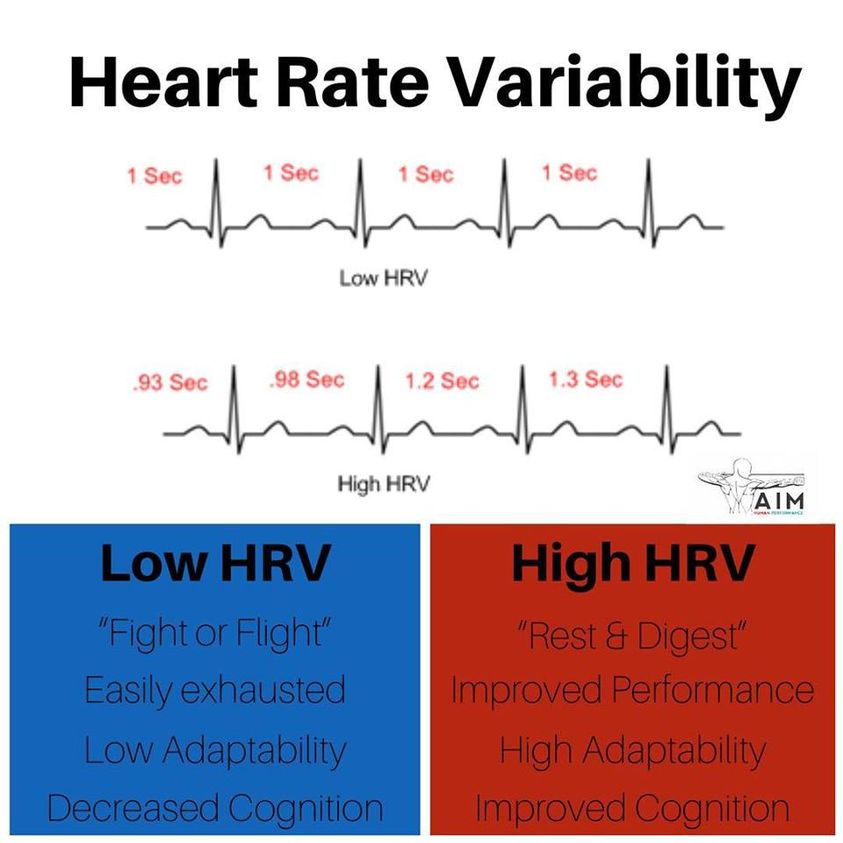Heart Rate Variability for Endurance Sports
Rest and Recovery, December 04, 2022
Recovery, both physical and mental, and improved fitness, is very important to us endurance athletes, due to training load, and busy lifestyles, and we have been known to push the limits of overreaching to overtraining.
What is HRV?

Historically, Heart Rate Variability (HR) is used by medical professionals, to determine heart health, and mental health issues like anxiety and depression. High HRV is generally considered an indicator of a healthy heart, and higher trend-baseline HRV has been found in many studies to be associated with reduced morbidity and mortality and improved psychological well-being and quality of life.
Recovery, both physical and mental, is very important to us endurance athletes, due to training load, busy lifestyles, and we have been known to push the limits of overreaching to overtraining (particularly ultra-distance athletes who’s training load, on top of normal life stressors put us ‘on-the-edge’).
Over the last 2-decades, sports science, and sporting communities, have seen HRV as a significant recovery evaluation and preparedness to train tool for athletes. Simply, HRV is a measure of your autonomic nervous system (ANS*) (i.e., the part of your nervous system that controls involuntary actions, such as the beating of your heart, breathing, and the widening or narrowing of your blood vessels) that can be extremely useful for evaluating your physical fitness and determining how ready your body is to physically ‘perform’. HRV is the variance in time between the beats of your heart. So, if your heart rate is 60 beats per minute, it’s not actually always beating once every second. Within that minute there may be 0.9 seconds between two beats, for example, and 1.15 seconds between two others. The greater this variability* is, measured in milliseconds, the more “ready” your body is to execute at a higher level. Higher daily heart rate variability is generally a sign of preparedness to train, and measured against an athlete’s personal baseline HRV, better fitness - the baseline is typically established over rolling 28-days. However, the most important things to know about HRV is that it is a measure of your life-stressors (i.e., not only exercises but both physical and mental stressors), an incredibly personalised metric that can differ greatly from one individual to the next, and better used as a trend against your HRV baseline and not in isolation. When attempting to figure out what is a good heart rate variability for you, several factors such as age, gender, fitness level, lifestyle stressors, environment, and genetics must be considered.
Significant technology improvements, over the last few years, has simplified HRV recording and evaluation, using HRV sensors (via specialised Apps or smart sports watches), detecting any changes in your ANS* by calculating your heart rate, heart rate variability, and even sleep quantity and quality, while also factoring in some of the other influences mentioned above, like age, gender, stress levels and environmental changes.
The sports technology community has seen the benefits for athletes (and resulting $$) of providing HRV analytics that are ‘linked’ to other metrics like sleep quantity and quality, training load, relaxation modes, breathing, etc. Now most popular sports watch manufacturers (e.g., Garmin, Polar, Apple, Whoop, etc.) and dedicated Apps (e.g., EHRV, AIO, HRV4Training, etc.) utilise HRV technology. If you have a sports watch and want more specific information on HRV, then I’d suggest you Google the brand and model with “heart rate variability”. Be warned however various studies have found that not all HRV tracking is as accurate as it could be, but it’s continually being refined.
*ANS affects the heart rhythm on a cellular level:
- The relaxation response tells your heart to slow down, making room for changes between beats (higher HRV)
- Your brain's fight-or-flight system tells your heart to speed up, reducing space for change (lower HRV).
More information: https://www.webmd.com/heart/what-is-heart-rate-variability
How can HRV practically support your recovery and training?
Firstly, as a coach I often see athletes barely utilise the functionality within their expensive smart watch. HRV (heart Rate Variability) can be a very useful tool for an endurance athlete to better support their understanding of their own body, better recovery mechanisms and fitness improvement, if they can better understand their relationship with training load, how they feel, their resting heart rate (RHR) and HRV outcomes.
It’s not always easy to figure how your body is responding to the training load – duration and/or intensity, or how external factors to training impact your preparedness (e.g., environmental, sleep quality, nutrition timing, hydration levels, life-stressors, menstrual cycle, etc.), and whether you’re ready for more training or need additional recovery and/or rest. Your subjective feeling is an important indicator, as is your resting heart rate (RHR), of course, but it’s often useful to combine it with objective measurements to see the big picture. Utilising your Heart Rate Variability (HRV) score isn’t about throwing out your daily or weekly or monthly training program*, it’s a little more complicated than that.
HRV is an indicator of the state of your health and fitness, recovery, and physical and mental readiness. This makes for a valuable objective tool to monitor during your regular daily training and program phases. Although more benefit is attained by your HRV baseline trends than an individual daily HRV score, a high daily HRV potentially indicates a day to attempt that time trial test or high intensity workout or race PB. A low daily HRV should lead to an active recovery day or even rest day, if other indicators dictate, such as subjective feel.
Research also correlates HRV to illness risk and/or progression, morbidity and mortality, biological age and health, physical performance, and mental cognition.
Some ways to maintain or help improve your HRV score, include daily 'intentional' breathing exercises (and/or meditation and yoga), maintain good hydration and nutrition at the right times, improve quality and quantity of sleep, and a more appropriate or personalised training program for you.If you haven't guessed already, these are the same things that support a fitter and faster you too and taking some of the guess work out of the equation.
Although your HRV baseline trend will decline as you age (e.g., same as your maximum heart rate does!), if you’re making efforts to better your overall health and fitness, over time you should see your HRV begin to rise or be significantly higher than non-athletes of the same age. It should be highlighted again that HRV is individual specific and there’s little benefit from making comparisons with other athletes.
Heart rate variability score can be a key component to your daily recovery - basically a readiness score for how prepared your body is to perform. Many smart watches and HRV Apps quantify the strain you ‘take-on’ each day and lets you know how hard to work out to meet your fitness goals, which in turn will support your improved HRV baseline trends over time. Your HRV (and resting heart rate - RHR) should be taken shortly after you wake up (e.g., common protocol for many HRV Apps which use an ECG chest sensor). Many sports watches with HRV/RHR capability, however, use an optical heart rate wrist sensor, and when worn 24/7 (i.e., during sleep), then synced with your watches App, will provide you with various metrics daily. Watch brands (e.g., Garmin, Polar, Apple, Whoop, etc.) and HRV Apps (e.g., EHRV, AIO, HRV4Training, etc.) tend to complicate HRV and your training readiness, as differing terminology is used to provide the same information and outcome – therefore it’s important to be across the specifics of your chosen HRV technology being used.
Interpreting HRV changes, daily score against your baseline - a brief guide!
- An increase in HRV with a decrease in RHR (resting heart rate) generally means an athlete is coping well with training.
- An increase in HRV with an increase in RHR is generally a sign of accumulated fatigue unless it's in the early stage of intense training block (there's a need to monitor closely!).
- A decrease in HRV with an increase in RHR is generally a sign of accumulated fatigue unless an athlete is tapering and then it could be a positive sign for readiness to perform.
- A decrease in HRV with a decrease in RHR is generally a sign of prolonged low-intensity high volume training. If your HRV cannot be reversed with rest, it could be a sign of being in an overtraining state.
Additionally, HRV can dip below baseline values for a day or two after an especially taxing workout or race. Athletes also can experience an increase during times of illness, when the immune system is in overdrive. The exact opposite of what you would expect if HRV monitoring were a simple tool. Essentially, understanding how HRV changes day to day and over time on a personal level, due to various life and exercise stressors and recovery modes, are important. Especially when positive and negative 'scoring' days are not always what they seem. This makes HRV a tricky, but not impossible, metric if you have a little time to put the measures into context for you^, with things like training load and intensity, sleep quality, nutrition, and other life stressors. HRV provides a great opportunity to better understand your own body and what influences your performance – positively and negatively – over time.
*Your HRV score isn’t about throwing out your daily or weekly or monthly training program however it’s another recovery and readiness tool that can be used to influence the training load on any given day, to enhance your training longevity and reduce illness and injury risk.
^How you feel is still very important and listening to your body (and not to rely totally on tech!). For those of us with lengthy endurance experience, I'm sure like me, you know your body 'tells' when you are pushing too close to your personal training fatigue limits. I'm not talking muscle fatigue, soreness or feeling flat. My overreaching to overtraining 'tells' are - some (PB or very) fast training times, followed the next week by minor nose bleeds, then very dry skin on my arms.
If you would like to discuss your endurance training program please message me direct #tnbcoaching
